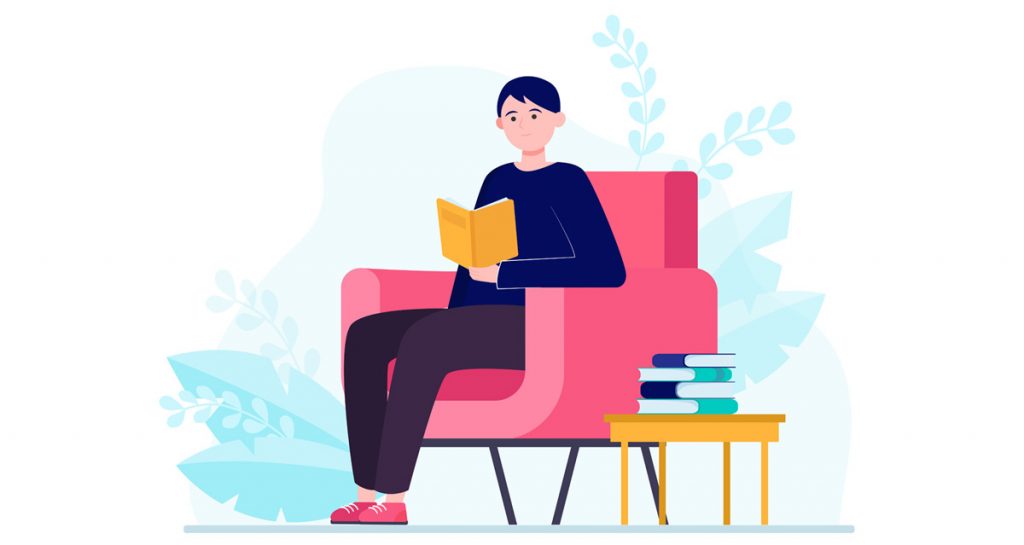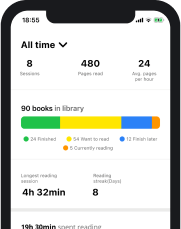The way we retain information as we read is an important aspect of the reading experience, and one with an undeniable importance. Reading is one of the most powerful learning tools at our disposal and our ability to retain information is responsible for the amount of time and effort we are forced to put into a learning task.
That is why many memorization techniques have been developed and one of the most popular ones is, as you probably already know, spaced repetition. Using the spaced repetition system to improve your information retention level while reading comes with a series of benefits and drawbacks. We will be exploring them all further below.
What is spaced repetition and how does spaced repetition work?
By its official definition, spaced repetition is an evidence-based memorization or learning technique that relies on a person’s ability to remember a certain piece of information that is presented to the subject at increasing time intervals.
In its original form, the technique is performed with flashcards and consists of asking a subject to memorize the contents of each card. New cards and those with more difficult information are shown with a higher frequency, while the older and simpler ones are displayed less frequently. This exploits the psychological spacing effect, improving one’s ability to retain information.
So how does the spaced repetition technique actually work? Well, while the principle is relatively simple, the practice may turn out to be rather challenging. Using spaced repetition requires you to constantly review the information you need to remember at ever increasing time intervals.
Let’s assume you want to remember a quote from your favorite book. To increase your chances of remembering word for word and making sure you don’t forget it, the spaced repetition technique dictates that you should re-read it a couple of times at increasing time intervals, for example:
- You read it now for the first time, you like it and want to remember it.
- Read it again after 4 hours
- Re-read it after another 8 hours
- Repeat after another 12 hours
- Once more after 24 hours
This is a simplified example and is not indicative of the exact intervals that should be used or the exact number of repetitions required to ensure that you retain that piece of information.
The entire process may seem a little complicated due to the increasing time intervals that are required on every step. Lucky for you though, Basmo can help out. Taking our same example with the quote from above, Basmo is extremely helpful when it comes to remembering information from books or simply storing the valuable info for later use. Here’s why.
Basmo can be used for saving your favorite quotes while you read a book. During a reading session in our app, you have the option to write notes that remain saved within the book and you can go back and check your notes anytime.
Not only that, but using the page scanner that is integrated into our reading tracking app will allow you to even extract the text directly and save it as a quote. Needless to say, this makes going back and re-reading the quote you want to remember a lot easier than searching for it in the book.
On top of this, the scheduling feature integrated into the Basmo app allows you to schedule your reading sessions at any interval you desire and the app will even remind you at the right time through gentle notifications.
Does Spaced Repetition Really Work?
Now that you know what spaced repetition learning means and how to do spaced repetition, it’s time to learn a bit more about how effective it really is. The short answer is that yes, the spaced repetition study method really works.
This memorization technique uses a couple of solid principles our brain is operating according to. It is based on scientific facts about the way our mind works and even though it was actually coined as a concept all the way back in 1885 by German psychologist Hermann Ebbinghaus in his experimental study called “Memory: A contribution to experimental psychology”, the technique is still one of the most commonly used mnemonic devices.
Did studies confirm that spaced repetition is effective?
Since our desire for the perfect memory has been an age-old quest for many generations, scientists have closely examined every single memorization technique ever conceived hoping it would prove itself the Holy Grail we’ve been looking for.
The spaced repetition technique has been at a center of a series of important studies since 1939 until very recently in 2020. Here’s what scientists managed to find out about spaced repetition.
1939
The first official study on spaced repetition as an information retention technique was conducted in 1939 by Herbert J. Spitzer. He was intrigued by Hermann Ebbinghaus’s paper from 1887 and he decided to investigate. His study had quite promising results but none of his fellow scientists seemed to be too interested in the subject and the impact of his study was unfortunately almost non-existent in the scientific community.
1989
50 years later though, the concept of spaced repetition caught Frank N. Dempster’s eye and he started studying the method in great detail. After going through more than 100 studies and reading pretty much everything that had ever been written on the subject, he published his own review of the relevant literature on this mnemonic device in the Educational Psychology Review.
His conclusion: the evidence was in favor of spaced repetition as a functional memorization technique and that it can be successfully used in a wide variety of settings, on different types of materials and within separate procedures.
1991
Following Dempster’s review, a new study was conducted in 1991 by a research team from the university of Villenova in the United States. The team developed a learning experiment in two parts, as follows:
- The first part of the experiment was conducted on young children (from preschoolers to third graders) and the conclusion was obvious: there was a relationship between the increasing intervals between repetitions and the children’s ability to recall certain information. In other words, the more spaced the repetition became, the better the child’s recalling ability.
- The second part focused on college students and the results were exactly the same.
Therefore, this two-part study managed to prove two separate things: spaced repetition works and it works just as well at any age during the school/college years.
2019
Fast forward to 2019 and things really start to get interesting. A team at the Beijing Normal University in China conducted a research on why spaced repetition works, using modern technology to confirm their theories and explain the phenomenon.
With help from EEG data, spatiotemporal pattern similarity data analysis and a lot of computing power to process the information and locate the relevant pattern in brain activity, they were able to pinpoint the biological basis for the effectiveness of spaced repetition.
During spaced repetition learning, they discovered an increase in electrical activity in the right frontal part of the brain, which is responsible for the retention of information, therefore confirming that spaced repetition works by making the process more intense and creating stronger neuronal connections.
How to properly use Spaced Repetition
Properly learning how to use spaced repetition while reading or learning takes a certain amount of motivation and perseverance, but the results will definitely be more than satisfying.
There’s a couple of things you need to keep in mind if you want to be successful in improving your information retention potential. Luckily for you, we know them all, and soon you will too.
How Often Should You Use Spaced Repetition?
While there is no perfect answer that works exactly the same for each individual, researchers have managed to agree on a couple of intervals for the spacing effect that seemed to have shown the best results in the majority of the subjects.
How often you should review what you read or learn depends a lot on the quantity of information you need to retain, how long it takes you to go through all of it, how soon you need to use it and a lot of other factors, so even though the “winning formula” below may look like the right choice, the only way to find out exactly what works best for you is to experiment.
Let’s look at it this way: you won’t be able to use a spaced repetition schedule to remember a poem and then use the same schedule for memorizing an entire book.
According to researchers, the best intervals for optimal spacing effect depend on the agreed upon forgetting curve and should be organized like this:
- Day 1 – learning and review
- Day 7 – active recall and spaced repetition (review)
- Day 16 – active recall and spaced repetition (review)
- Day 35 – active recall and spaced repetition (review)
Different learning schemes do exist and they can prove to be equally effective depending on the factors I mentioned above.
What is The Best Spaced Repetition Schedule
The best repetition schedule for the optimal spacing effect is the one you try out, experiment and discover that works well for you and the topic you are on. As much as I would like to be able to provide you with a winning formula that works on everything, this is virtually impossible.
So instead of doing that, let me tell you a bit about creating your own spaced repetition schedule. That way you can experiment with different intervals according to what you are focused on remembering and you can customize it to fit your needs and preferences.
The easiest way to go about doing this is using a spreadsheet template. You just need to download it, personalize it and use it according to the instructions in the first sheet. Once you get the hang of it, you can start adjusting the intervals and testing your performance. Keep adjusting and find the perfect schedule.
Once you have it, it’s time to start making things even easier for yourself by using spaced repetition with Basmo, the reading tracking app. Use the app to write summaries on the topics you need to remember and highlight the important parts of the books you read so you can find them easier when it’s time to review them.
Basmo allows you to make notes while reading, scan pages of the book and even extract the text. Everything is easily formattable so you can always make the most information stand out. On top of this, Basmo can help you schedule your review sessions, as the built-in scheduling feature allows you to be as flexible as you want.
How to use spaced repetition to remember what you read?
Using spaced repetition to remember what you read is less common, but definitely effective and worth trying if what you read is important enough to remember. Depending on what you are trying to remember and the size of the text, there are several options.
- For small parts of the text: create your own repetition schedule and use Basmo to scan the part of the text you need to remember. Read it, set the schedule with Basmo for the desired spacing intervals and whenever it’s time for a review, simply pick up your phone, open the app and re-read the text you initially scanned.
- For bigger chunks of text: use Basmo to make notes on the important information in the text or even to write a review for the entire book/novel in the journaling feature. According to the repetition schedule, you create and set with Basmo, use the app to review the text, your notes or the summary you wrote in order to remember everything and ensure a long lasting memory.
Another thing you can do is use spaced repetition as a general memory enhancement tool. Using the Anki spaced repetition app for example, which uses the same flashcard memorization system that was initially at the basis of spaced repetition, is a proven way of improving your memorization capacity.
By exercising constantly, your brain will be more agile, you will find it easier to create strong, long-lasting memories about the things that are important to you. The less it takes you to memorize things in general, the more information you will retain by reading, without any additional effort.
Conclusion
Spaced repetition is an incredibly powerful tool for your learning and reading habits. Use it in the right way, find your optimal spacing intervals and use Basmo to make things easier for yourself and the results will come sooner than you think!
Give Your Reading Experience
An Extra Boost With Basmo
Track the books you read, monitor the time you spend reading and keep notes on your reading habits and how it makes you feel. You can set yourself targets for the time you spend reading and you can get notified whenever you’re behind on your reading time.
Peace of mind vector created by pch.vector – www.freepik.com







